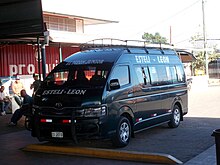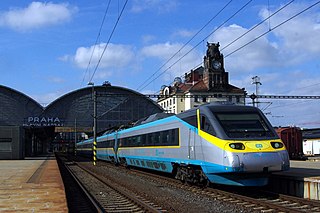Road transport
The road infrastructure is very well spread across the Pacific side, while the Atlantic side has less infrastructure. As of 2009, from a total of 19,137 km 2,033 km are paved and 17,104 km are unpaved. [1]
Public transport
Public transport in Nicaragua is mostly served by buses on both short and wide range distances. There are five different types, based on the size of the vehicle, target group, frequency of stops and distance. [2]
Urban buses


Urban buses (Urbanos) can be found in Managua, Estelí, León, Chinandega, Matagalpa and Bluefields. In most cases, passengers have to pay for each ride on a bus, with the need to pay again when switching to another. The costs differ from 2.50 C$ in Managua to 10 C$ in Bluefields. [2]
An urban bus in Nicaragua takes the same road multiple times per day, following a more or less strict schedule. The organization of the buses in different towns differs heavily as every town is organizing it on their own behalf. In Estelí, every bus driver is assisted by mostly two persons helping them (Ayudantes). Bus drivers in Managua have to manage their jobs on their own. [2]
Another fact that heavily differs is the vehicles used in the different cities. In Managua mostly urban buses sponsored by Russia are used, in Estelí former school buses from the United States, in Bluefields Japanese light commercial vans and in León pickup trucks that got extended with seats and a roof. [2]

The quality of bus stops also heavily differs. In the center of Managua many proper bus stops exist with roofs or at least signs, in other areas there often isn't any indication of a bus stop. Nevertheless, buses serve a network of established stops with common names known by bus assistants. Passengers need to know or ask where and when which bus stops. [2]
To improve the accessibility of public transport, in 2016 the OpenStreetMap group in Nicaragua MapaNica crowdsourced with the help of more than 150 citizens of Managua the first bus transit map in the whole of Central America. [3] Later in 2018, they made this data machine-accessible, serving it today in different apps on several platforms. [4]
Urban buses in Managua will be use Brazilian dual-mode bus and hybrid electric bus that are currently in evaluation process.
Suburban buses
Suburban buses (Suburbanos) connect larger cities with communities in outer areas. They only stop a few times inside the city, later nearly everywhere where passengers request to get off. Like with urban buses, a team serves a route several times per day and the service is organized by the local government. Prices can vary depending on the distance. [2]
Ruteados

Connecting two or more cities, Ruteados (also called Servicio Ordinario) are the biggest part of bus services in Nicaragua. [2]
Express buses

Express buses (Expresos) connect, like Ruteados and share taxis, two or more cities, but with less stops, resulting in a faster travel time. [2]
Share taxis

Share taxis are called Interlocales in Nicaragua and also connect two or more cities, like Ruteados and express buses, with the main difference that they depart from the bus station once they are filled either mostly or completely with passengers. Like express buses, they nearly don't stop between start and destination. [2]








